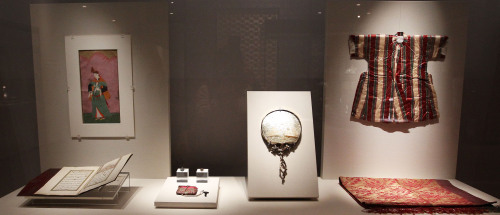Coffee should be as dark as hell, as strong as death and as sweet as love.
It’s no wonder this famous coffee-themed proverb is from Turkey. After all, the world’s first coffeehouse was established in the 17th century Istanbul, during the time of the Ottoman Empire. The Ottoman sultans’ love for coffee was notorious; they had at least six maids serving the beverage, using some of the most expensive burners, pots and cups ― all made of silver and diamonds.
The lavish coffee-drinking culture is just one aspect of the Turkish civilization. Starting this week, the National Museum of Korea’s special exhibition is offering a rare opportunity for Seoulites to see exquisite collections of Turkish relics. A total of 184 artifacts are showcased in four different sections, categorized by the time periods: The ancient Anatolian civilizations, the Greek and Roman Civilizations, the Eastern Roman Empire, and the Ottoman Empire (1299-1923).

Mirrors, garments and ornaments from the Ottoman Empire are on display at the National Museum of Korea. (The National Museum of Korea)
The first section of the exhibition features the relics of the ancient Hittites, the first civilization to use iron.
“The Hittites enjoyed a high level of culture and development,” said associate curator Kim Se-won of the museum. “They are famous for their iron weapons, which were much stronger than the ones made of bronze. They are also known for the Treaty of Kadesh, which is considered the world’s first peace treaty.”
Some of the most significant relics in this section include a tablet inscribed in the Cuneiform script, which is the surviving legal document written by Hattushili I (1586-1556 B.C.) ― a Hittite king. “The words of the king are like steel,” he wrote.
“They cannot be changed, disobeyed, or ignored. Anyone who changes his words will be beheaded.”
Turkey is also home to countless artifacts from the Greek and Roman civilizations. The country in fact has more Greek and Roman ruins preserved than Greece and Italy, according to Kim. Viewers will be given a rare opportunity to see some beautiful marble sculptures of the Greek and Roman heroes, including Alexander the Great.
The most fascinating of the exhibits are, undoubtedly, the relics from the Ottoman Empire. The culture of the Ottoman Empire was deeply rooted in Islam and the items from this time period show off vivid colors and splendid use of jewels and stones, revealing the sultans’ absolute power and their lavish lifestyle.
Sultans’ everyday items, including colorful garments, a silver ashtray, a crystal ladle, and a turban ornament decorated with colorful gems, including rubies, pearls, diamonds and emeralds, are on display.
Aside from coffee, the Ottoman sultans also enjoyed a very high level of culinary culture.
“The Ottoman cuisine was developed from the 15th century and was created by an elite group, who lived near the royal palace in Istanbul,” said Kim. “The culinary culture included everything from picking the right ingredients, method of cooking, and table manners to building of the kitchens.”
Viewers will have a chance to see some of the soup bowls and food plates, all made of silver and gold. According to Kim, the royal palace of the 16th century Ottoman Empire served more than 40 different types of soups everyday. Among them, its chicken soup and rice soup were often used as medicine.
The Muslim faith also deeply influenced the Ottoman royals’ bathing culture. They always used flowing water rather than stagnant pools, and thought that was the religiously proper way of cleansing themselves. The exhibition features a few pairs of high-heeled bath shoes worn by the Ottoman royals, which are made of silver.
“The shoes were high-heeled because the royals wanted to avoid stepping into water,” said Kim. “The height of the heels also reflected your status. The royals of higher status would wear shoes with higher heels.”
One should also make sure to check out the Quran chest, which was used to store the holy text of Islam. It is made of wood and decorated with precious materials such as pearls and ivory. The exhibition also showcases a copy of the Quran from the Ottoman Empire, its texts inscribed in gold.
Osman Murat Suslu, Turkey’s general director of museums and cultural heritage, was in Seoul to attend the opening of the exhibition on Monday.
“Korea and Turkey have been exchanging culture for thousands of years,” he said during a press meeting in Seoul. “I hope this exhibition can boost Turkish-Korean relations.”
The National Museum of Korea will also host a special exhibition featuring Korean ceramics in Turkey, from May to August of next year.
“The Civilizations of Turkey: Emperors in Istanbul” runs until Sept. 2 at the Special Exhibition Gallery of the National Museum of Korea. For more information, call (02) 2077-9000.
By Claire Lee (dyc@heraldcorp.com)


![[Herald Interview] 'Amid aging population, Korea to invite more young professionals from overseas'](http://res.heraldm.com/phpwas/restmb_idxmake.php?idx=645&simg=/content/image/2024/04/24/20240424050844_0.jpg&u=20240424200058)



